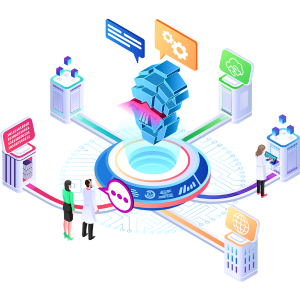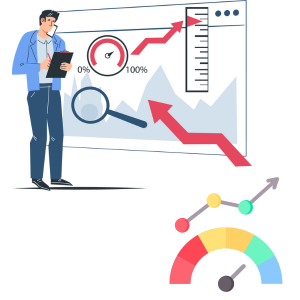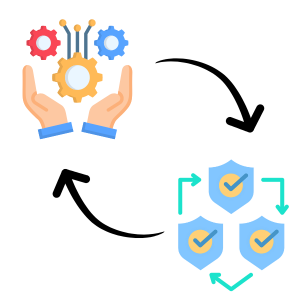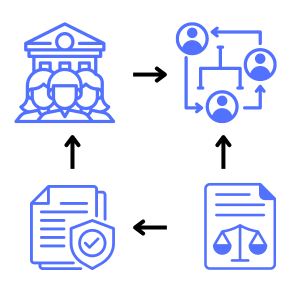
Experion’s expertise in Snowflake Data Warehouse integration powers up data management solutions that are not just scalable, but game-changing! We help organizations take their data-driven operations to the next level, achieving remarkable results. Picture a world where data is as fluid and accessible as turning on a tap. Snowflake Data Warehouse has turned this vision into reality, revolutionizing data warehousing with a fresh, cloud-native approach that’s as effective as it is affordable, a boon for Digital Transformation processes. Snowflake breaks free from the constraints of traditional on-premises and outdated cloud solutions. At the heart of Snowflake’s magic is its innovative architecture, designed exclusively for the cloud. Cloud-based data storage is revolutionized by Snowflake Data Warehouse, which offers scalable, efficient, and secure solutions for managing and analyzing large volumes of data. Cloud data warehousing This unique structure combines the formidable power of data warehousing with the flexibility of big data platforms and the limitless scalability of the cloud. The result is a high-performance, low-cost solution that empowers businesses to harness their data potential fully.
Snowflake’s recent financial report is like a glowing beacon in the world of business, showing how people are eagerly embracing its offerings. Analysts highlight Snowflake’s robust financial health, evidenced by strong product revenue growth and impressive margins. In the third fiscal quarter, Snowflake reported revenues of $734.2 million, surpassing estimates with a 33.6% year-over-year increase. The surge in product revenue growth tells us that more and more people are finding value in what Snowflake brings to the table. And let’s not forget those impressive margins.
What is Snowflake Data Warehouse?
It’s a dynamic, scalable solution that grows with your business, ensuring your data is always accessible, secure, and ready to drive insights. Snowflake is more than a data warehouse; it’s a game-changer, turning the complex world of data into a realm of exciting possibilities. With Snowflake, there are no limits to what you can achieve.
The company’s platform facilitates data storage, processing, and analytics, enabling businesses to efficiently harness the power of their data. Snowflake’s services address a wide range of data needs, including data warehousing, data lakes, data engineering, data science, data application development, and collaboration.
Snowflake Data Warehouse – Key features
Architecture: Multi-cluster Shared Data Architecture
 Snowflake employs a groundbreaking architecture called multi-cluster shared data architecture, offering:
Snowflake employs a groundbreaking architecture called multi-cluster shared data architecture, offering:
- Shared Storage: Data resides in a secure, central cloud storage layer, eradicating data silos and ensuring universal access to the latest information.
- Independent Virtual Warehouses: Snowflake creates temporary virtual warehouses (compute clusters) in the cloud for querying data. These warehouses operate independently from the storage layer, allowing for:
- Elastic Scaling: Easily scale virtual warehouses up or down based on processing needs, ensuring optimal performance and cost efficiency.
- Massively Parallel Processing (MPP): Queries are distributed across these virtual warehouses, enabling parallel processing and faster results on large datasets.
Scalability
Snowflake’s architecture inherently supports scalability:
- Independent Scaling of Storage and Compute: Scale compute resources (virtual warehouses) independently of storage to adjust to varying workloads without affecting data availability.
- Automatic Scaling: Snowflake effortlessly adjusts the scale of virtual warehouses in response to workload demands, guaranteeing peak resource utilization without the need for manual intervention.
Performance
Snowflake delivers impressive performance through:
- MPP Architecture: Distributing queries across multiple virtual warehouses allows for parallel processing and faster execution.
- Columnar Storage: Storing data in a columnar format streamlines processing time by accessing only pertinent data columns during queries.
- Cloud-Native Design: Leveraging cloud infrastructure, Snowflake ensures high-performance data processing.
Security
Snowflake prioritizes security with:
- Encryption: Industry-standard encryption algorithms are applied to your data to maintain its integrity and confidentiality, whether it’s at rest or on the move.
- Role-based Access Control (RBAC): Users are assigned roles with specific permissions, ensuring controlled access to sensitive data.
- Secure Data Sharing: Snowflake enables secure data sharing with other organizations while maintaining granular control over access levels.
Data Sharing
Snowflake facilitates secure and collaborative data sharing:
- Secure Data Shares: Create secure shares of data with other Snowflake accounts, allowing access to specific datasets without compromising security.
- Governed Sharing: Granular access controls ensure only authorized users can access shared data.
- Cloud Data Sharing: Leveraging cloud infrastructure, Snowflake enables seamless and secure data sharing across organizations and locations.
Snowflake Data Warehouse – Benefits
Here are the major benefits of Snowflake:
Benefit
|
Description |
| Cost Efficiency
|
Flexible Pricing: Snowflake operates on a pay-as-you-go pricing model, eliminating upfront costs and allowing optimization of spending based on actual usage.
|
| Streamlined Management: Snowflake handles infrastructure, maintenance, and updates, reducing the administrative burden on IT teams. | |
| Scalable Resources: Scale compute resources up or down as needed to avoid paying for unused capacity. | |
| Ease of Use | Intuitive Interface: User-friendly interface enables effortless data access and analysis for analysts and business users.
|
| Standardized Query Language: Utilizes universally understood SQL, facilitating adoption for users with varying levels of SQL proficiency.
|
|
| Empowering Analytics: Empowers data analysts to independently explore and analyze data, fostering self-reliance and agility in decision-making. | |
| Data Integration | Seamless Data Connectivity: Integrates seamlessly with diverse data sources, including relational databases, cloud storage platforms, NoSQL databases, and data streaming services.
|
| Automated Data Ingestion: Snowpipe automates data ingestion from various sources into Snowflake, streamlining the data loading process.
|
|
| Open Ecosystem Compatibility: Supports open standards and APIs, facilitating integration with a wide range of third-party data tools and ETL processes. | |
| High Availability and Reliability | Redundant Infrastructure: Incorporates redundancy across multiple data centers and availability zones, ensuring uninterrupted service and minimizing downtime.
|
| Automated Backup and Recovery: Performs automatic backups and offers disaster recovery features to safeguard data integrity and ensure business continuity. | |
| Continuous Service Uptime: Strives for uninterrupted service availability and provides robust service level agreements (SLAs) for uninterrupted data warehouse operations. |
Snowflake Data Warehouse – Use Cases
Snowflake Data Warehouse offers real-world applications and use cases, showcasing its practicality in various scenarios.
Business Intelligence (BI) and Analytics:
 Centralized Data Hub: Snowflake serves as a single source of truth, consolidating all organizational data into one platform. This centralization facilitates seamless integration with various BI tools and dashboards, eliminating silos and ensuring consistency in data analysis across departments.
Centralized Data Hub: Snowflake serves as a single source of truth, consolidating all organizational data into one platform. This centralization facilitates seamless integration with various BI tools and dashboards, eliminating silos and ensuring consistency in data analysis across departments.
Self-service Analytics: Empowering business users with self-service analytics capabilities, Snowflake enables them to explore and analyze data independently without relying on IT or data engineering teams. This fosters a culture of data democratization, where insights are readily accessible to all stakeholders, driving informed decision-making at every level of the organization.
Ad-hoc Analysis: Snowflake’s flexible and scalable architecture allows analysts to perform ad-hoc queries and dive deep into the data to uncover valuable insights on the fly. Whether it’s exploring new trends, investigating anomalies, or answering spontaneous business questions, Snowflake provides the agility and performance needed for iterative and exploratory analysis.
Accelerated Time to Insights: With its high performance and scalability, Snowflake drastically reduces the time to insights, enabling organizations to extract value from their data at unprecedented speed. Whether it’s processing massive datasets or running complex analytical queries, Snowflake ensures that decision-makers have access to real-time or near-real-time insights, empowering agile and data-driven decision-making.
Data Engineering
 Streamlined Data Ingestion: Snowflake simplifies the process of ingesting data from diverse sources, whether it’s structured or semi-structured, batch or streaming. Features like Snowpipe enable continuous data loading, automating the ingestion pipeline and ensuring that data is always up-to-date and readily available for analysis.
Streamlined Data Ingestion: Snowflake simplifies the process of ingesting data from diverse sources, whether it’s structured or semi-structured, batch or streaming. Features like Snowpipe enable continuous data loading, automating the ingestion pipeline and ensuring that data is always up-to-date and readily available for analysis.
Efficient Data Transformation: Data engineers leverage Snowflake’s powerful processing capabilities to perform data cleaning, transformation, and preparation tasks directly within the platform. With support for SQL-based transformations and integration with ETL tools like Matillion and Fivetran, Snowflake streamlines the data engineering workflow, enabling teams to focus on deriving value from data rather than managing infrastructure.
Enhanced Data Quality: By providing a centralized platform for data management, Snowflake ensures consistency and integrity across datasets, thereby improving data quality. Features like data sharing and data replication enable seamless collaboration and replication of curated datasets across environments, ensuring that all stakeholders have access to trusted and up-to-date data for analysis and decision-making.
Collaborative Work Environment: Snowflake fosters collaboration among data engineers, data scientists, and analysts within a unified environment. With support for role-based access control (RBAC) and granular permissions, teams can collaborate securely on shared datasets and projects, driving innovation and knowledge sharing across the organization.
Machine Learning
 Scalable ML Platform: Snowflake provides a scalable and cost-effective platform for storing, managing, and analyzing large-scale datasets required for training machine learning models. With its separation of storage and compute layers, Snowflake allows data scientists to scale compute resources dynamically based on the demands of their ML workloads, thereby optimizing cost and performance.
Scalable ML Platform: Snowflake provides a scalable and cost-effective platform for storing, managing, and analyzing large-scale datasets required for training machine learning models. With its separation of storage and compute layers, Snowflake allows data scientists to scale compute resources dynamically based on the demands of their ML workloads, thereby optimizing cost and performance.
Integration with Data Science Tools: Snowflake seamlessly integrates with popular data science tools and libraries such as Python, R, TensorFlow, and sci-kit-learn, enabling data scientists to leverage their existing workflows and tools of choice. Whether it’s building and training ML models in Jupyter notebooks or deploying models using frameworks like TensorFlow Serving, Snowflake provides the flexibility and interoperability needed for end-to-end ML workflows.
Feature Engineering and Model Training: Snowflake accelerates the feature engineering and model training process by providing native support for complex SQL operations and distributed computing. Data scientists can leverage Snowflake’s powerful SQL engine to perform feature engineering at scale and train ML models directly on the platform, eliminating the need to move data between different systems and accelerating time-to-insight.
Model Deployment: Snowflake enables seamless deployment and management of ML models in production environments, whether it’s batch scoring or real-time inference. With its support for user-defined functions (UDFs) and external functions, Snowflake allows data scientists to deploy models directly within SQL queries, enabling real-time scoring and integration with business applications and processes.
Real-time Analytics
 Near Real-time Data Processing: Snowflake supports near real-time data ingestion and processing, enabling organizations to analyze streaming data and derive insights in real-time. Whether it’s monitoring IoT devices, analyzing clickstream data, or detecting anomalies in financial transactions, Snowflake provides the scalability and performance needed for real-time analytics at scale.
Near Real-time Data Processing: Snowflake supports near real-time data ingestion and processing, enabling organizations to analyze streaming data and derive insights in real-time. Whether it’s monitoring IoT devices, analyzing clickstream data, or detecting anomalies in financial transactions, Snowflake provides the scalability and performance needed for real-time analytics at scale.
Real-time Analytics Dashboards: With Snowflake, organizations can build interactive and responsive dashboards that provide real-time visibility into key metrics and KPIs. Whether it’s monitoring sales performance, tracking website traffic, or analyzing social media sentiment, Snowflake enables organizations to make data-driven decisions in real-time and respond quickly to changing market conditions.
Fraud Detection and Anomaly Identification: Snowflake’s capabilities enable organizations to detect fraudulent activities and anomalies in real-time by analyzing streaming data and historical patterns. Whether it’s detecting credit card fraud, identifying network intrusions, or preventing money laundering, Snowflake provides the analytical tools and infrastructure needed to protect against emerging threats and mitigate risks in real-time.
Enhanced Customer Experience: By analyzing streaming data in real-time, organizations can personalize customer experiences and deliver targeted interventions at the moment of interaction. Whether it’s recommending products, personalizing offers, or resolving customer issues, Snowflake enables organizations to deliver seamless and personalized experiences that drive customer satisfaction and loyalty.
Snowflake Data Warehouse vs Other Data Warehouses
When comparing Snowflake Data Warehouse to other data warehouses reveals unique benefits and innovative features that set it apart. Let’s check them out:
Snowflake Advantages:
- Cloud-based: Snowflake operates entirely in the cloud, eliminating the need for businesses to invest in upfront hardware infrastructure. This cloud-native approach simplifies management and allows for seamless scalability.
By leveraging Snowflake’s cloud-native architecture, Experion empowers businesses to enhance data accessibility and performance, driving operational efficiency and cost-effectiveness.
- Scalability: One of Snowflake’s key features is its ability to independently scale storage and compute resources based on specific workload requirements. This flexibility ensures optimal performance and cost-effectiveness.
- Cost-effectiveness: Snowflake follows a pay-as-you-go pricing model, which means businesses only pay for the resources they consume. This can result in significant cost savings compared to traditional fixed infrastructure expenses.
- Ease of Use: Snowflake offers a user-friendly web-based interface and supports familiar SQL language for data access and analysis. This simplicity streamlines the onboarding process for users and enhances productivity.
- Automatic Updates: Snowflake handles software patching and upgrades automatically, freeing businesses from the hassle of managing these tasks and ensuring they always have access to the latest features and security enhancements.
Traditional Data Warehouse Advantages:
- Potential Lower Long-term Costs: For organizations with exceptionally high and constant data volumes, traditional on-premise solutions might offer lower long-term costs due to reduced dependency on cloud service fees.
- Customization: On-premise solutions provide greater control over hardware and software configurations, allowing businesses to tailor their infrastructure to specific needs and preferences.
Snowflake vs. Cloud Data Warehouses (Redshift, BigQuery, Azure Synapse):
Shared Strengths:
- All these solutions are cloud-based, offering scalability, flexibility, and the ability to access data from anywhere with an internet connection.
- They all support standard SQL, making it easier for users familiar with SQL to transition to these platforms for data analysis and querying.
Snowflake’s Distinctions:
- Unique Architecture: Snowflake’s architecture separates storage and compute, enabling independent scaling of resources. This approach can result in potentially lower costs and improved performance for certain workloads.
- Ease of Use: Snowflake is often praised for its intuitive interface and user-friendly SQL implementation, making it accessible to a wide range of users.
- Data Sharing: Snowflake excels in secure data sharing capabilities, allowing organizations to share data easily and securely with external partners or clients.
Other Cloud Warehouses’ Potential Advantages:
- Integration with Cloud Ecosystem: Redshift seamlessly integrates with other AWS services, BigQuery is native to the Google Cloud Platform (GCP), and Azure Synapse works within the Microsoft Azure ecosystem. This integration can be advantageous for users heavily invested in a specific cloud provider’s suite of tools.
- Pricing: Pricing structures for cloud data warehouses can vary based on workload and usage patterns. In specific scenarios, other cloud data warehouses might offer lower costs compared to Snowflake.
Choosing the Right Cloud Data Warehouse
Consider factors such as scalability requirements, data sharing needs, cloud platform preference, cost structure, usage patterns, user experience, and technical expertise when selecting the most suitable cloud data warehouse for your organization’s needs and priorities.
Getting Started with Snowflake Data Warehouse
Setting up Snowflake Data Warehouse involves the following:
Account Setup
- Visit Snowflake’s website and sign up for a free trial.
- Receive confirmation email with login credentials.
- Access Snowflake through web interface (Snowflake Web UI) or command-line interface (SnowSQL).
Data Loading
- Use Snowpipe for continuous data loading from cloud storage (AWS S3, Azure Blob Storage, GCP Cloud Storage).
- Utilize Snowstage as a temporary storage area for data files before loading into tables.
- Create External Stages to reference data files in external cloud storage.
- Connect directly to various data sources like relational databases, NoSQL databases, and data streaming services.
Basic Operations
- Run queries using standard SQL language in Snowflake Web UI’s query editor.
- Manage virtual warehouses for query processing: create, start, stop, and resize as needed.
- View and browse data stored in tables.
- Manage user access by creating users and assigning roles with specific permissions.
- Explore security features like role-based access control and data encryption.
Snowflake Data Warehouse – Best Practices
Performance Optimization
 Optimize Queries: Write efficient SQL queries to reduce processing time and resource usage.
Optimize Queries: Write efficient SQL queries to reduce processing time and resource usage.
Choose the Right Warehouse Size: Select virtual warehouses matching workload needs to avoid overprovisioning.
Utilize Clustering Keys: Cluster tables based on frequently used columns to improve query performance.
Materialized Views: Create pre-computed data summaries for frequently accessed data subsets.
Cost Management
 Leverage Auto-Scaling: Use Snowflake’s automatic scaling to optimize virtual warehouse usage.
Leverage Auto-Scaling: Use Snowflake’s automatic scaling to optimize virtual warehouse usage.
Schedule Warehouses: Run virtual warehouses only when needed, especially for batch processing.
Utilize Credits and Free Trials: Make the most of free trials and credits during setup and learning.
Monitor Usage and Costs: Regularly review Snowflake usage and cost reports for optimization.
Security Practices
 Implement RBAC: Assign roles with specific permissions to limit data access.
Implement RBAC: Assign roles with specific permissions to limit data access.
Enable MFA: Require multi-factor authentication for user logins.
Encrypt Data: Ensure data encryption at rest and in transit.
Monitor User Activity: Keep an eye on user activity logs for security monitoring.
Data Governance
 Establish Data Ownership: Clearly define data ownership for accountability.
Establish Data Ownership: Clearly define data ownership for accountability.
Implement Data Quality Checks: Enforce data quality checks to address inconsistencies.
Data Lineage Tracking: Track data origin and flow for transparency.
Standardization and Documentation: Standardize data formats and documentation for clarity.
Snowflake Data Warehouse – Future Trends
 Snowflake has shared intriguing insights and forecasts about the future of their data warehouse, highlighting key trends anticipated to shape 2024.
Snowflake has shared intriguing insights and forecasts about the future of their data warehouse, highlighting key trends anticipated to shape 2024.
- Generative AI and Large Language Models (LLMs) are expected to have a transformative impact, enabling innovative applications and enhancing user experiences in data access and manipulation. Snowflake is also exploring how AI and data can be tailored to specific sectors, with particular attention to trends in finance, healthcare, manufacturing, and more.
- Data democratization and governance are becoming increasingly important. Snowflake’s data indicates a growing utilization of data governance features and a rise in queries against governed data. This trend reflects how companies are achieving a balance between making data widely accessible and ensuring its security.
Conclusion
2024 promises to be a year of significant innovation for Snowflake, with a strong emphasis on leveraging AI and generative technologies to enhance data accessibility and value for businesses further. Looking ahead to 2024, several additional trends are expected to influence Snowflake’s direction. As the fields of data science and AI progress, Snowflake will likely focus on seamless integration with cutting-edge data analysis and visualization tools to enhance its platform’s capabilities. Additionally, with heightened concerns about data breaches and evolving privacy regulations, Snowflake is anticipated to prioritize robust data security measures.
Key Takeaways
- Snowflake’s Multi-Cluster Shared Data Architecture eliminates data silos, enabling elastic scaling and massively parallel processing (MPP) for high accessibility and performance.
- Snowflake offers independent scaling of storage and compute resources, with automatic adjustments based on workload demands for optimal resource utilization.
- Leveraging MPP architecture and columnar storage, Snowflake ensures impressive performance, enabling faster query execution and high-performance data processing.
- Snowflake prioritizes security with encryption, role-based access control (RBAC), and secure data sharing features, ensuring data integrity and confidentiality.
- Snowflake facilitates secure and governed data sharing, allowing seamless collaboration across departments, partners, and locations while maintaining granular access controls.
- With a flexible pricing model and streamlined management, Snowflake optimizes spending based on actual usage, eliminating upfront costs and handling infrastructure maintenance and updates.
- Snowflake provides an intuitive interface and standardized SQL language, empowering users with varying proficiency levels to access and analyze data effortlessly.
- Snowflake seamlessly integrates with diverse data sources, supports automated data ingestion, and is compatible with third-party data tools, streamlining data integration processes.
- Snowflake ensures continuous service uptime with redundant infrastructure, automated backup, recovery features, and robust service level agreements (SLAs), minimizing downtime and safeguarding data integrity.
- Catering to various use cases including BI, analytics, data engineering, machine learning, and real-time analytics, Snowflake empowers organizations with centralized data management, self-service analytics, efficient data transformation, and real-time insights.
With Experion’s tailored Snowflake data integration services, companies can streamline their data processes, improve decision-making, and achieve long-term business scalability.

